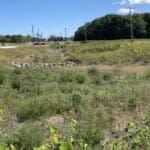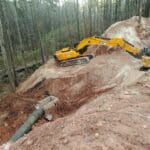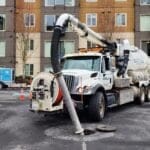City of Decatur
On Monday, April 21, 2014, the City of Decatur established a stormwater utility. It is a way to fund the cost of municipal stormwater management services.
Like electricity, water and sanitary sewers, stormwater runoff can be managed as a utility. The utility will be supported by fees that every property owner within the City will be billed for on the City Utility Bill. The service charge will be based on the amount of runoff generated from each property. A way to quantify that runoff amount is to measure the amount of impervious surface on a property. Hard, impervious surfaces do not allow water to soak into the ground and, instead, stormwater runs off the property.
Implementation
The Stormwater Utility Service Charge will be implemented in 2 phases:
Phase 1
From November 2014 to October 2015, every parcel in the City of Decatur will receive a $3.00 per month base fee service charge. Tax-exempt properties will be exempt from Phase 1 charges.
Phase 2
Beginning in November 2015, every parcel in the City of Decatur will be charged based on the following:
- Residential Properties that are 1 acre or less will be charged a $3.00 base fee + $0.67 ERU fee per month.
- Residential properties over 1 acre will be charged a $3.00 base + $0.67 x ERUs per month.
- Non-residential properties will be charged a $3.00 base + $0.67 x ERUs per month.
- Tax exempt properties will be charged like non-residential properties.
What’s an ERU? The Equivalent Residential Unit (ERU) is the average amount of impervious surface contained on residential properties. In Decatur, 1 ERU is 4,500 sf. So, for example, if a property has 45,000 sf of impervious surface, they would have 10 ERUs. (45,000 ÷ 4,500 = 10)
Utility Fee
The stormwater utility fee is based on the amount of impervious surface area on a property. The average impervious area on residential properties in Decatur was calculated to be 4,500 square feet. This amount of impervious square footage is considered to be one (1) Equivalent Residential Unit (ERU). Nonresidential parcels would have their ERU’s calculated based on the amount of impervious area found on the property. All residential parcels would have 1 ERU.
The rate structure is a base fee of $3.00 for all property parcels combined with a rate of $0.67 per ERU.
For the first year of the stormwater utility fee (Oct. 2014 to Sept. 2015), only $3.00 per parcel will be charged to property owners and no fee will be charged to tax-exempt parcels.
16. Stormwater Management Plan Requirements
The storm water management plan shall include sufficient information to allow the City Engineer to evaluate the environmental characteristics of the project site, the potential impacts of all proposed development of the site, both present and future, on the water resources, and the effectiveness and acceptability of the measures proposed for managing stormwater generated at the project site. To accomplish this goal the stormwater management plan shall be prepared in accordance with the City of Decatur Storm Drainage Policy and include the following:
(a) Soils information when a stormwater management control measure depends on the hydrologic properties of soils (e.g., infiltration basins), then a soils report shall be prepared by a qualified person and submitted with the plan. The soils report shall be based upon on-site boring logs or soil pit profiles and soil survey reports. The number and location of required soil borings or soil pits shall be determined based on what is needed to determine the suitability and distribution of soil types present at the location of the control measure.
(b) A permanent elevation benchmark shall be identified in the plans to assist in the periodic inspection of the facility using the North American Vertical Datum of 1988 (NAVD).
(c) A landscaping plan detailing the revegetation of the site after the construction is finished as set forth in Section 17 of this Ordinance.
(d) A maintenance plan for all stormwater management facilities to ensure the continued performance of the facilities subject to the approval of the City Engineer. The plan shall:
(1) Identify the parts or components of said facilities that need to be maintained and inspected;
(2) Provide detailed maintenance and repair procedures for the said facilities;
(3) Identify necessary training, skills or certifications that may be required to maintain, operate or repair any of the said facilities;
(4) Provide that the minimum maintenance and repair needs include, but are not limited to:
-
- The removal of silt, litter, landscape wastes and other debris which adversely impacts the effectiveness of the said facilities;
- The management of landscaped areas integral to the said facilities including the cutting of grass, trimming of bushes and trees or the removal of vegetation overgrowth that is not incorporated into the storm water management plan;
- iii. The replacement of landscape vegetation and damaged or failed facilities;
- The cleaning of storm drainage inlets, pipes and structures;
- Revising and implementing revisions or additional maintenance procedures to address inadequacies of the facilities.
(5) Provide for the regular periodic review, inspection and evaluation of the effectiveness of the maintenance program by qualified personnel for the purpose of documenting maintenance needs. Such reviews and inspections shall be conducted at least once every year after the construction is finished;
(6) Provide for established reporting procedures;
(7) Provide that maintenance needs are addressed in a timely manner.
(e) An executed maintenance agreement as agreed to by the City Engineer that assigns the responsibility for compliance with the maintenance plan required in paragraph (d) of this Section to the owner of the property on which the stormwater facilities are located to ensure compliance with the purpose and requirements of this Ordinance. Said agreement shall be a part of the owner’s declaration and by appropriate notation referenced on the plat and:
(1) Include as part of said agreement the maintenance plan as approved by the City Engineer;
(2) Provides that the property owner will arrange to have the periodic inspection of the stormwater facilities specified in the maintenance plan conducted by a qualified person who will submit a sealed report of the inspection to the City Engineer;
(3) Grant permission to the City Engineer to enter the property at reasonable times and inspect the stormwater facility to ensure that it is being properly maintained;
(4) Provide that the property owner shall be responsible for additional maintenance needs consistent with the needs and standards outlined in the Illinois Urban Manual;
(5) Provide that maintenance needs must be addressed in a timely manner, on a schedule determined by the City Engineer;
(6) Provide that if the property is not maintained in compliance with the approved schedule, the City Engineer shall have the authority to have the maintenance work performed at the City’s expense, and bill the same to the property owner which shall be a lien against the property.
(f) Dedication of easements necessary to ensure access to the site for the purpose of maintenance and inspection of the storm water management facilities. These easements must be binding on the current property owner and all subsequent owners of the property and must be properly recorded as a commitment against the property.
(g) The City shall have the discretion to accept the dedication of any existing or future stormwater management facility, provided such facility meets the requirements of this Ordinance, and includes adequate and perpetual access and sufficient areas, by easement or otherwise, for inspection and regular maintenance. Any stormwater facility accepted by the City must also meet the City’s construction standards and any other standards and specifications that apply to the particular stormwater facility in question.
17. Landscaping and Stabilization Requirements
(a) Any area of land from which the natural vegetative cover has been either partially or wholly cleared by development activities shall be revegetated according to a plan approved by the City Engineer.
(b) A plan for establishing permanent vegetative cover to stabilize disturbed or exposed areas must be submitted with the stormwater pollution prevention plan. The plan shall describe the vegetative stabilization and management techniques to be used at a site after construction is completed using BMPs. This plan will explain how the site will be stabilized after construction, who will be responsible for the maintenance of vegetation at the site and what practices will be employed to ensure adequate vegetative cover is preserved.
(c) Where it is required by the BMP, this plan must be prepared by a registered Landscape Architect in the State of Illinois.
Links:
 Kenosha, Wis. Highway KR Regenerative Stormwater ConveyanceThe Root-Pike Watershed Initiative Network Kenosha County, and others worked with AQUALIS to design and implement an innovative solution for stormwater control along Highway KR.
Kenosha, Wis. Highway KR Regenerative Stormwater ConveyanceThe Root-Pike Watershed Initiative Network Kenosha County, and others worked with AQUALIS to design and implement an innovative solution for stormwater control along Highway KR. Durham, N.C. Sinkhole Leads to Stormwater System RehabilitationThe tenant on this property noticed a depression that opened to the ground below and notified the property owners.
Durham, N.C. Sinkhole Leads to Stormwater System RehabilitationThe tenant on this property noticed a depression that opened to the ground below and notified the property owners.
